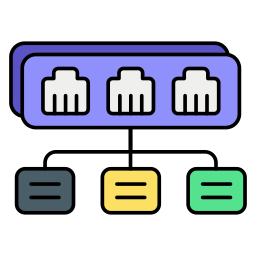
Hub and Network Hardware Components
A hub is one of the most basic network hardware components used in computer networking. It operates at the physical layer (Layer 1) of the OSI model and serves as a central connecting device in a network. When a hub receives a data packet from one of its ports, it broadcasts the data to all other ports, regardless of the intended recipient. This lack of data filtering makes it simple but inefficient for large or busy networks.
Main Features and Functions of a Hub
It acts as a central connection point for devices in a local area network (LAN).
It transmits data packets to all connected devices, not just the intended one.
It does not manage any traffic coming through it.
It cannot differentiate between devices or understand MAC addresses.
It is mainly used in small networks where data traffic is minimal.
Types of Hubs
Passive Hub: Simply connects the devices and allows data to flow without any processing.
Active Hub: Regenerates and amplifies the signal before sending it to other ports.
Smart Hub: Includes minimal management features, like monitoring network traffic.
Other Essential Network Hardware Components
Switch
A switch operates at the data link layer (Layer 2) and can also function at the network layer (Layer 3).
Unlike hubs, switches can identify the devices connected to each port using MAC addresses.
Switches direct data only to the intended recipient, reducing unnecessary traffic.
Commonly used in modern LANs because of better performance and efficiency.
Router
Routers operate at the network layer (Layer 3) and are used to connect different networks together.
They manage traffic between networks and assign IP addresses.
Routers can connect to the internet and route data to and from external networks.
They include security features like firewalls and network address translation (NAT).
Modem
A modem converts digital data from a computer to analog for transmission over telephone lines and vice versa.
It is essential for connecting to the internet via DSL or telephone lines.
Modern modems often include router functionality.
Network Interface Card (NIC)
A NIC is a hardware component inside a computer that allows it to connect to a network.
It can be wired (Ethernet) or wireless (Wi-Fi).
It handles the physical transmission of data and provides a unique MAC address for each device.
Access Point
An access point enables wireless devices to connect to a wired network.
It is used to expand wireless coverage in larger areas.
Access points do not manage traffic like routers but extend connectivity.
Firewall Hardware
A firewall can be a standalone hardware device that monitors and controls incoming and outgoing network traffic.
It provides security by filtering data packets based on predefined security rules.
Patch Panel
A patch panel organizes and connects incoming and outgoing LAN cables.
It is typically used in network cabinets or server rooms.
It helps in managing complex cable systems and facilitates troubleshooting.
Repeater
A repeater regenerates and amplifies the network signal to extend the range of the network.
It is used when the distance between two network devices is too long for direct communication.
Bridge
A bridge connects two separate LANs and filters traffic to ensure only necessary data passes through.
It helps in managing traffic and reducing collisions in a network.
Gateway
A gateway acts as a translator between different network protocols.
It connects networks using different architectures, such as LAN to WAN.
Gateways are often used in enterprise environments.
Usage and Costs
Basic hubs are generally inexpensive and sometimes come bundled with other network devices.
Most modern networks prefer switches over hubs due to their better efficiency.
Switches, routers, and modems can range in price depending on their features and performance.
NICs and patch panels are usually low-cost hardware, especially for standard consumer use.
Firewalls and access points vary in price based on their capabilities, with enterprise-grade devices being more expensive.
Repeaters, bridges, and gateways are generally used in specific situations and priced according to their complexity and function.
Many of these hardware components are purchased outright, and there are no recurring costs unless bundled with services (like ISP-provided routers or modems).
Comparison of Hub with Other Network Devices
A hub is less efficient than a switch because it cannot direct traffic to specific devices.
Unlike routers, hubs cannot connect to external networks or assign IP addresses.
Switches offer much better performance by reducing network collisions and managing traffic intelligently.
Routers provide more advanced functionality, such as internet connectivity and security.
Access points and NICs are not replacements for hubs but work in tandem with other devices to facilitate network access.
Conclusion
Hubs are simple, entry-level network hardware components primarily used for connecting devices in small and low-traffic networks. They serve as central connection points but do not manage or filter data traffic, making them inefficient for most modern networking needs. As networks grow in size and complexity, devices like switches and routers become essential for effective data management, speed, and security. While hubs may still be found in basic setups or educational environments, their use has significantly declined due to the availability of more advanced and affordable alternatives. Ultimately, choosing the right network hardware depends on the size, purpose, and required performance of the network.












